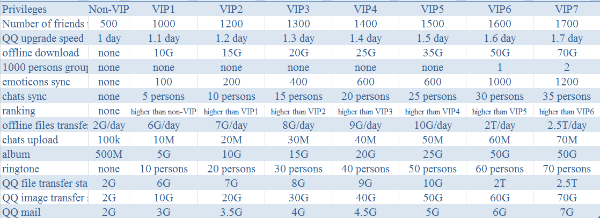
How Tencent Made Billions with QQ Membership
How does Tencent make billions from its membership? Today we will discover the membership secret of Tencent's money machine.
Establish QQ Membership Hierarchy System
When Tencent established membership system, the key point was to charge members. How can Tencent make members continue to pay for QQ services? Tencent came up with membership hierarchy system, to make members sense the identity difference. Tencent has built 7 levels of hierarchy membership system, each of which enjoys different privileges.
For example, if you are VIP1, growing to VIP2 need 600 credits. Suppose daily credit is 5, then you need 120 days to grow to VIP2, which means four months membership fees. Tencent said a good membership hierarchy system should satisfy the basic need of customers, give users expectations and increase the cost of leaving. The main features of Tencent membership system are the identity difference and expectations.
In order to make it work, the difference between levels has to be big enough to arouse motivation for users to upgrade. Besides, the upgrade speed has to slow down as the level goes up. For example, upgrading from VIP1 to VIP2 takes 600 credits, and upgrading from VIP2 to VIP3 takes 1200 extra credits.
In this way, the hierarchy system forms a pyramid structure. Designers have to make the user distribution in different levels suitable, not letting users to get to another level too fast, otherwise it would be difficult to maintain the users in a single level. What's more, the top level has to be extremely hard to get and rare, attractive, becoming the pursuit of all users.
Last but not least, Tencent has to create new top level in the appropriate time to sustain the growth of users, give them expectations." When the number of top level users is close to the second high level, it is time to create a new top level," said by the membership product manger Mr. Liu in Tencent.
To set up a membership hierarchy is not difficult, what's difficult is to maintain the system. Tencent reminds VIP members at all possible occasions of their levels, upgrade speed and goals to achieve. For example, when a member upgrade to a higher level, Tencent would send an email explaining all the privileges enjoyed by this level users.
Tencent motivates members by specified numbers, like ranking, to make them sense accomplishment. It is crucial to keep the hierarchy equal to every member, nobody can jump to next level.
Knowing the Need of Customers, Improving Customer Segmentation
In 2011, Tencent found some people sold QQ VIP membership symbol for 1 yuan (USD 0.16), and what's astonishing was about 3 million users bought this service.
Instead of warning the illegal sellers and punishing users who bought the service by cancelling their membership symbols, Tencent sent messages to these 3 million users and gave them 20% off for VIP membership. 15% of these users turned QQ VIP members.
Another example was the design of membership fee notification. Tencent designed two proposals, and tested them together in different groups of users, finally decided to adopt one according to the reaction of users.
Because Tencent has a large user database, so most of decisions are based on data analysis, and Tencent could target different groups of users to achieve customer segmentation. Membership management has built up a model of the existing members, new members and lost members.
Read more: Rise of Tencent Empire





